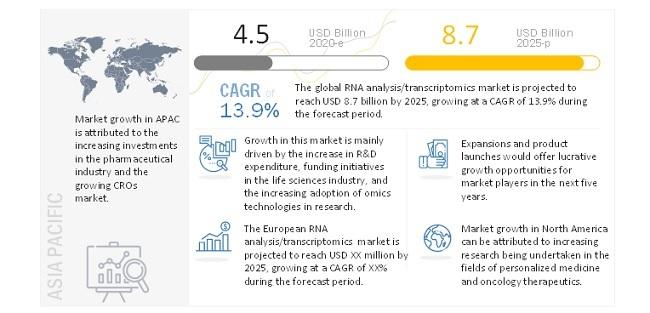The increasing focus on biomarker discovery and toxicogenomics, along with the increasing interest in outsourcing services, is expected to offer significant growth opportunities for the players operating in the global RNA analysis/transcriptomics market. On the other hand, the requirement of high capital investments and data management issues are expected to restrain the growth of this market to a certain extent.
[ 196 Pages Report] The RNA analysis market is projected to reach USD 8.7 billion by 2025 from USD 4.5 billion in 2020, at a CAGR of 13.9% during the forecast period. The growth of this market is majorly driven by the increasing demand for personalized medicine, increasing pharmaceutical and biotechnology R&D expenditure and government funding for omics.
According to the Personalized Medicine Coalition report (2017), the number of personalized drugs, treatments, and diagnostic products has increased since 2006, and this trend is expected to continue in the coming years.
Personalized medicine, which has become a core area of research in the healthcare industry, has entered mainstream clinical practice and is changing how many diseases are identified, classified, and treated. These advancements are particularly evident in the area of oncology.

Download PDF Brochure @ https://www.marketsandmarkets.com/pdfdownloadNew.asp?id=240344576
Biomarker identification, along with its clinical applications, has simplified drug discovery and development procedures in terms of evaluating the toxicity and efficacy of drugs. Besides, biomarkers for diseases like cancer, CVD, and neurological diseases are playing an integral role in enabling a better understanding of the disease pathway and progression.
The microarray technology used in transcriptomic analysis offers the promise of widespread study of diseases at the genomic level. It also aids in developing novel clinical biomarkers, identifying novel molecular abnormalities, and investigating drug efficacy.
Microarray experiments for transcriptomic studies produce enormous amounts of data. Therefore, researchers typically face problems in the interpretation of results and exploiting available computational power to process said data. Moreover, RNA sequencing data from transcriptomics studies have low genome coverage and high amplification bias, which makes data analysis extremely challenging, especially without effective bioinformatics tools. Many existing tools developed for bulk cell sequencing have not been effective in the analysis of transcriptomics data.